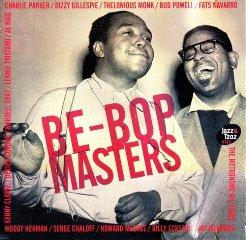Be-Bop Masters (2005)
Be-Bop Masters (2005)

1 –Kenny Clarke - 52nd Street Theme 2 –Dizzy Gillespie - Bebop 3 –Dizzy Gillespie Charlie Parker - Hot House 4 –Billy Eckstine - Blowin' The Blues Away 5 –Dexter Gordon Wardell Gray - The Chase 6 –Jay McShann - Swingmatism 7 –Thelonious Monk - Round Midnight 8 –Bud Powell - Dance Of The Infidels 9 –Lennie Tristano - Interlude 10 –Howard McGhee - Down Home 11 –Fats Navarro - Nostalgia 12 –Serge Chaloff - Blue Serge 13 –Al Haig - Pennies From Heaven 14 –Woody Herman - Apple Honey 15 –Metronome All Stars - Victory Ball 16 –Charlie Parker Dizzy Gillespie - A Night In Tunisia
World War II brought an end to the heyday of swing. Big bands began to shrivel, as musicians were sent overseas to fight. For this reason, the 1940s saw a surge in smaller ensembles, such as quartets and quintets. Groups often consisted of one or two horns, usually saxophone and/or trumpet, bass, drums, and piano. Smaller groups meant that the focus shifted from intricate arrangements to improvisation and group interaction.
Adventurous Improvisation
Swing arrangements mainly consisted of composed sections, but with certain sections designated for improvisation. A bebop tune, however,, would simply consist of a statement of the head, or main theme, extended solos over the head’s harmonic structure, and then one final statement of the head. It was common for bebop musicians to compose new, complex melodies over well-known chord progressions. One example of this is Charlie Parker’s “Ornithology,” which is based on the changes from “How High the Moon,” a popular show tune in the 1940s.
Beyond Swing
With the focus on improvisation, bebop allowed for an explosion of innovation. Inspired by the more harmonically and rhythmically experimental players in swing era, such as Coleman Hawkins, Lester Young, Art Tatum, and Roy Eldridge, bebop musicians expanded the palette of musical devices from which to choose while improvising. Many aspects of swing were imported, including the triplet-based swing feel and a proclivity for the blues.
Typically however, bebop musicians played tunes at much faster tempos. Soloists did not concern themselves as much with lyricism, but more with rhythmic unpredictability and harmonic complexity. It wasn’t just the soloists who were important, however. The advent of bebop marked an expansion of the roles of the rhythm section players, who were no longer simply time-keepers, but who interacted with the soloist with their own embellishments.
Nonsense Syllables
The term “bebop” is an onomatopoeic reference to the accented melodic lines of the music. Sometimes shortened to “bop,” the name was most likely given to the style music retroactively, as the musicians themselves often referred to their style simply as “modern jazz.” ---Michael Verity, jazz.about.com
download (mp3 @320 kbs):
yandex 4shared mega mediafire zalivalka cloudmailru uplea
